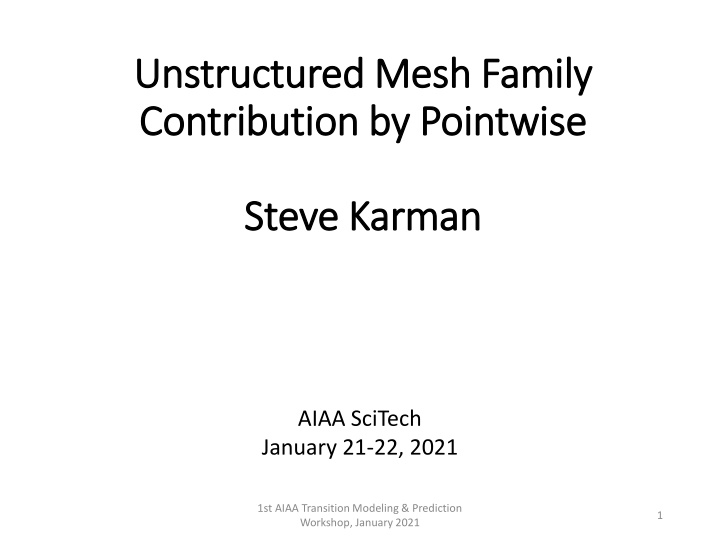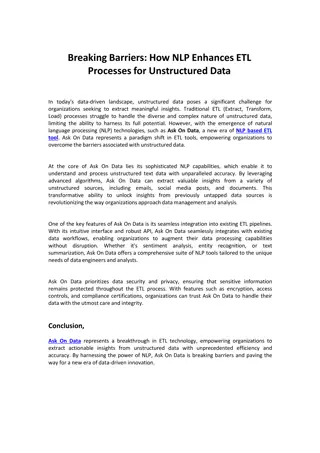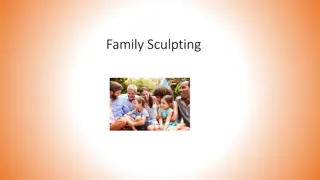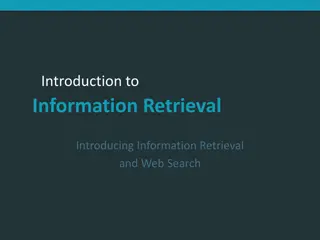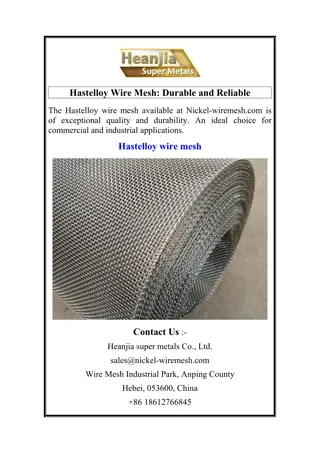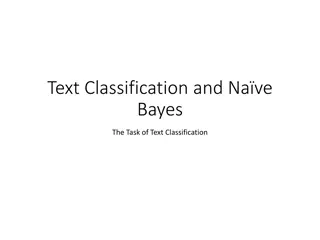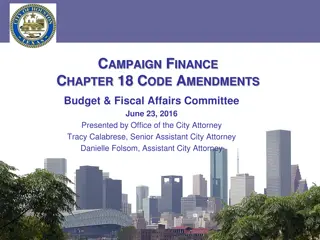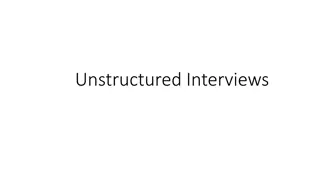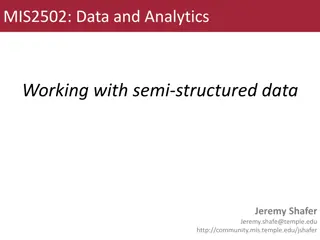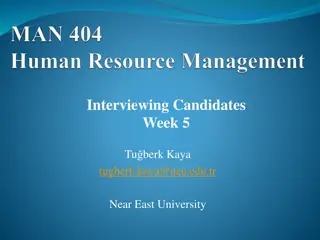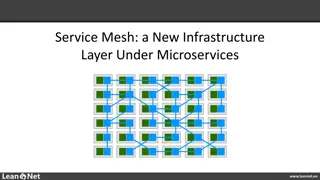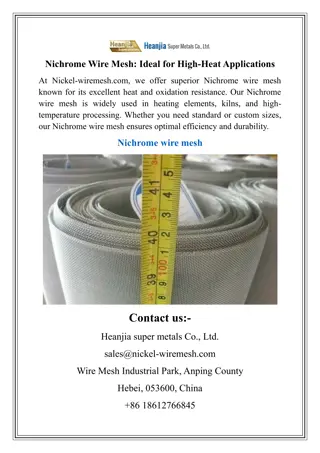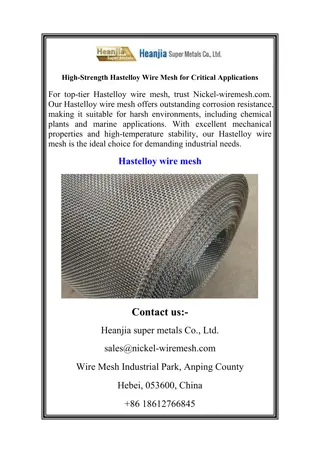Unstructured Mesh Family Contribution by Pointwise in AIAA SciTech Workshop
This content discusses the contribution of the Unstructured Mesh Family by Pointwise in the AIAA SciTech workshop, covering topics such as meshing guidelines, geometry issues, and solutions presented. It delves into the challenges faced in surface meshing and provides insights on improvements made to address these issues. The content also highlights the utilization of specialized scripts and refined meshing techniques to enhance the mesh quality in aerodynamic simulations.
Download Presentation

Please find below an Image/Link to download the presentation.
The content on the website is provided AS IS for your information and personal use only. It may not be sold, licensed, or shared on other websites without obtaining consent from the author.If you encounter any issues during the download, it is possible that the publisher has removed the file from their server.
You are allowed to download the files provided on this website for personal or commercial use, subject to the condition that they are used lawfully. All files are the property of their respective owners.
The content on the website is provided AS IS for your information and personal use only. It may not be sold, licensed, or shared on other websites without obtaining consent from the author.
E N D
Presentation Transcript
Unstructured Mesh Family Unstructured Mesh Family Contribution by Pointwise Contribution by Pointwise Steve Karman Steve Karman AIAA SciTech January 21-22, 2021 1st AIAA Transition Modeling & Prediction Workshop, January 2021 1
GeomToMesh for Initial Mesh Pointwise meshing via GeomToMesh Glyph scripts Geometry obtained from IGES file. Scripts follow a set process with best practices to automatically construct surface meshes and then single block volume mesh. User specifies minimum edge dimension, curvature resolution, surface normal spacing, growth rate and other parameters. GeomToMesh technical paper was presented at AIAA meeting (AIAA-2019-1721). Issues encountered with surface meshing on the wing leading edge required a deviation from the scripts for the family. A refinement script was then used to create coarser and finer meshes where the refinement factor was specified. 1st AIAA Transition Modeling & Prediction Workshop, January 2021 2
Meshing Guidelines Reference (Medium-Resolution) Grid Guidelines Viscous wall spacing: y+ 2/3 ( y1= 1.55 x 10-5inches) At least 2 constantly spaced cells at viscous walls ( y1 = y2) Growth rates: < 1.15X normal to viscous walls Wing spanwise spacing: < 0.08% * bref at root, Yehudi break, and tip Wing chordwise spacing: < 0.1% * local chord at LE and TE Wing TE base: at least 12 cells Spacing near fuselage nose and afterbody < 0.8% * cref Growth Rates Between Grids Scale grid dimensions consistently in all three computational directions Keep grid-spacing ratio between grid levels between 1.15 (8/7) and 1.5 (3/2) Farfield Boundaries > 100 semi-spans 1st AIAA Transition Modeling & Prediction Workshop, January 2021 3
Geometry Issue 1 Surface meshing using 2D Trex extrusion method was prematurely stopping. Pointwise developer determined the analytic normal were inverted along the leading edge. Solution: Decided to use diagonalized structured mesh on wing upper and lower surfaces. Since the meshes were made changed to Pointwise have corrected the issue. 1st AIAA Transition Modeling & Prediction Workshop, January 2021 4
Geometry Issue 2 Aft-Fuselage closure is tangent with symmetry plane at top and bottom locations (non-physical). Solution: Geometry trimmed small amount to create aft-facing surface. Same issue observed and changed for CRM-HL in HiLiftPW-4 1st AIAA Transition Modeling & Prediction Workshop, January 2021 5
Geometry Issue 3 Geometry assembly tolerance extremely large on wing root. On the order of the mesh spacing. (0.001078) Caused issues with mesh curving. Solution: Surface mesh spacing normal to the wing root juncture was increased. Since the meshes were made the projection of surface nodes to geometry in the curving code has been improved. 1st AIAA Transition Modeling & Prediction Workshop, January 2021 6
GeomToMesh Parameters & Resulting Tetrahedral Mesh Statistics Q1 Tet Series Q2 ~Curvature Angle Refine Series A TE_dim F delta S GR # nodes # Tets # nodes 4 4 0.66666667 0.0000465 2.5 16 262632 1516593 2065628 6 6 0.75 0.000031 1.666666667 10.66666667 833246 4873647 6590161 8 8 1 0.00002325 1.25 8 2914797 17248465 23171799 10 10 1.25 0.0000186 1.195440625 6.4 5467478 32439242 43517594 12 12 1.2 0.0000155 1.160397208 5.333333333 9192505 54643962 73231930 14 14 1.16666667 1.32857E-05 1.135996911 4.571428571 14308390 85168437 114057582 16 16 1.14285714 0.000011625 1.118033989 4 21034665 125331145 167752921 Generated mesh 8 first. Then used the refinement script to generate coarser and finer meshes. Medium mesh as defined in Meshing Guidelines is mesh 12 . The refinement factor (F) was input to the refinement scripts with the previous mesh loaded in Pointwise memory. Curving process adds more nodes to the mesh but the element count stays the same. 1st AIAA Transition Modeling & Prediction Workshop, January 2021 7
Tetrahedral Conversion to Prisms Mesh Statistics Q1 Tet Series Q2 Prism-Tet Series Refine Series A # nodes 262632 833246 2914797 17248465 5467478 32439242 9192505 54643962 14308390 85168437 21034665 125331145 # Tets 1516593 4873647 # nodes 2065628 6590161 23171799 43517594 73231930 114057582 167752921 # nodes 262632 833246 2914797 5467478 9192505 14308390 21034665 # Tets 442719 867278 1467756 2276104 3289983 4477498 5890587 #Pyrs #Pris 351810 1320187 5229167 9222 22904 46604 74750 10004546 110262 17044485 152059 26795607 203513 39677844 4 6 8 10 12 14 16 Hybrid mesh with prisms, pyramids and tetrahedra were created using the combine Trex option in Pointwise. Number of nodes does not change. Significant reduction in total element count is typical. 1st AIAA Transition Modeling & Prediction Workshop, January 2021 8
CRM_NLF_mesh4A_Q1 1st AIAA Transition Modeling & Prediction Workshop, January 2021 9
CRM_NLF_mesh4A_Q2 1st AIAA Transition Modeling & Prediction Workshop, January 2021 10
CRM_NLF_mesh4A 1st AIAA Transition Modeling & Prediction Workshop, January 2021 11
CRM_NLF_mesh12A_Q1 1st AIAA Transition Modeling & Prediction Workshop, January 2021 12
CRM_NLF_mesh12A_Q1 1st AIAA Transition Modeling & Prediction Workshop, January 2021 13
CRM_NLF_P-T_mesh16A_Q2 1st AIAA Transition Modeling & Prediction Workshop, January 2021 14
Summary GeomToMesh scripts used to create initial mesh Issues with extruding surface meshes were solved using triangulated structured meshes on wing surfaces. Aft-Fuselage tangency addressed by truncating small section of tail section. Large assembly tolerances required less clustering in the surface meshes to the wing/root juncture. Second refinement script was used to create coarser and finer meshes. Hybrid meshes created by tetrahedral stack combination process in Pointwise. Quadratic high-order meshes also created. 1st AIAA Transition Modeling & Prediction Workshop, January 2021 15
